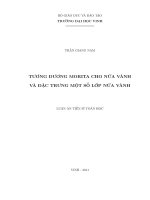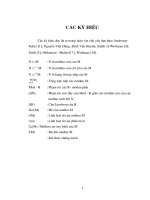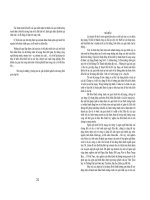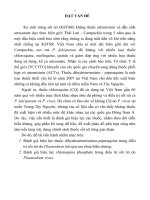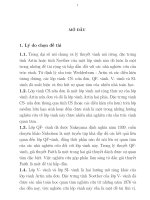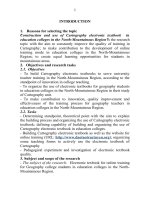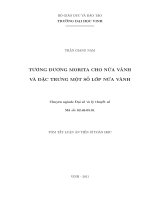tương đương morita cho nửa vành và đặc trưng một số lớp nửa vành bản tóm tắt luận án tiếng anh
Bạn đang xem bản rút gọn của tài liệu. Xem và tải ngay bản đầy đủ của tài liệu tại đây (224.27 KB, 21 trang )
MINISTRY OF EDUCATION AND TRAINING
VINH UNIVERSITY
TRN GIANG NAM
MORITA EQUIVALENCE FOR SEMIRINGS AND
CHARACTERIZE SOME CLASSES OF SEMIRINGS
ABSTRACT OF THE DOCTORAL THESIS
Speciality: Algebra and theory of numbers
Code: 62.46.05.01
Supervisors
1. ASSOC. PROF. SCI. DR. NGUYEN XUAN TUYEN
2. ASSOC. PROF. DR. NGO SY TUNG
VINH - 2011
1
Introduction
Semiring is introduced by Vandiver in 1934, generalize the notion of non-
commutative rings in the sense that negative elements don’t have exist. In this
thesis, semirings were assumed to have both additive identity and multiplicative
identiy.
Nowadays one may clearly notice a growing interest in developing the alge-
braic theory of semirings and their numerous connections with, and applications
in, different branches of mathematics, computer science, quantum physics, and
many other areas of science (see, for example, the recently published Glazek
(2002)). As algebraic objects, semirings certainly are the most natural gen-
eralization of such (at first glance different) algebraic systems as rings and
bounded distributive lattices. As is well known, structure theories for alge-
bras of classes/varieties of algebras constitute an important “classical” area of
the sustained interest in algebraic research. In such theories, so-called simple
algebras — algebras possessing only the identity and universal congruences —
play a very important role of “building blocks.” In contrast to the varieties of
groups and rings, research on simple semirings has been just recently started
and, therefore, not much on the subject is known (for some recent results on
this subject one may consult Bashir et al. (2001), Monico (2004), Bashir-Kepka
(2007) and Zumbragel (2008)).
In the same time in the modern homological theory of semimodules over
semirings, the results characterizing semirings by properties of semimodules
and/or suitable categories of semimodules over them are of great importance and
sustained interest (for some recent such results one may consult, for example,
Il’in and Katsov (2004), S. N. Il’in (2008), Y. Katsov (2004), O. Sokratova
(2002)).
At any rate, this thesis concerns the ideal- and congruence-simpleness- in a
semiring setting, these two notions of simpleness are not the same and should be
differed-for some classes of semirings. Also, comfirming a conjecture and solving
a problem of Katsov in the class of additively regular semisimple semirings.
The thesis is organized as follows. In Chaper 1, we present the number of
new results on projective semimodules, which extend to a non-additive semiring
setting the corresponding classical important facts on projective modules over
2
rings. We develop from two different, eventually equivalent, perpectives the
“Morita equibalence” concept in the category of semirings.
In Chapter 2, we establish that ideal-simpleness, congruence-simpleness and
simpleness of semirings are Morita invariants for semirings; and describe all
simple semirings having projective minimal left (right) ideals, and provide a
characterization of ideal-simple semirings having projective minimal left (right)
ideals.
In Chapter 3, we describe all ideal-simple and simple artinian aic-semirings,
as well as congruence-simple lattice-orderd semirings. Further, we also present
a complete desciription of left (right) subtractive semisimple semirings. Then,
apply this result, we describe left (right) subtractive artinian ideal-simple semir-
ings, as well as left (right) subtractive artinian congruence-simple semirings.
Finally, we describe all simple semirings with an infinite element, and provide a
characterization of ideal-simple semirings with an elements.
In Chapter 4, we describe all additively idempotent semisimple semirings
over that the notions of either projectiveness and flatness, or flatness and mono-
flatness for semimodules coincide. Also, we characterize semisimple semirings
by projective and injective semimodules.
3
Chapter 1
MORITA EQUIVALENCE
1.1 Background
In this section, we recall notions and facts on semirings and semimodules over
them that can be found in Golan (1999). Also, we recall the notion of tensor
product for semimodules in sense of Y. Katsov (1997).
From now on, let M
R
and
R
M be the categories of right and left semimodules,
respectively, over a semiring R.
1.2 Progenerators
In this section, we characterize, and describe progenerators — finitely
generated projective generators — of semimodule categories.
Now let S =
R
M(P, P ) := End (
R
P ) be a semiring of all endomorphisms
of a left R-semimodule
R
P ∈ |
R
M|. Then, considering endomorphisms of
R
P operating on the right of
R
P , one easily sees that P becomes an R-S-
semimodule, i.e.,
R
P
S
∈ |
R
M
S
|. As in the classical case of modules over rings,
we write Q = P
∗
:=
R
M(
R
P,
R
R) for the dual S-R-semimodule P
∗
of the R-
S-semimodule P. We also define the endomorphism qp ∈ S by p
(qp) = (p
q)p
for any p ∈ P and q ∈ Q. Then, in the same fashion as has been done in the
classical case of modules over rings, one can easily obtain the following.
Lemma 1.2.2. The assignments (p, q) −→ pq and (q, p) −→ qp define
the (R, R)-homomorphism α : P ⊗
S
Q −→ R and the (S, S)-homomorphism
4
β : Q ⊗
R
P −→ S, respectively.
Our next observation provides a characterization of finitely generated pro-
jective left R-semimodules
R
P ∈ |
R
M| by means of the homomorphism
β : Q ⊗
R
P = P
∗
⊗
R
P −→ S = End (
R
P ) from Lemma 1.2.2 above.
Proposition 1.2.4. A left R-semimodules
R
P ∈ |
R
M| is finitely generated and
projective iff β : Q ⊗
R
P −→ S is a surjection.
Now we turn to generators in the semimodule categories.
Definition 1.2.6. A left semimodule
R
P ∈ |
R
M| is said to be a generator for
the category of left semimodules
R
M if the regular semimodule
R
R ∈ |
R
M| is
a retract of a finite direct sum ⊕
i
P of the semimodule
R
P .
Similar to Propositions 1.2.4, our next observation provides a characterization
of finitely generated generator
R
P ∈ |
R
M| for
R
M by means of the homomor-
phism the (R, R)-homomorphism α : P ⊗
S
Q −→ R from Lemma 1.2.2. above.
Proposition 1.2.8. A finitely generated left semimodule
R
P ∈ |
R
M| is a
generator for
R
M iff the (R, R)-homomorphism α : P ⊗
S
Q −→ R is a
surjection. Moreover, if α is a surjection, then it is an isomorphism.
Combining the concepts of ‘generator’ and ‘finitely generated projective
semimodule’, we come up with a new concept of ‘progenerator’, namely: A
left semimodule
R
P ∈ |
R
M| is said to be a progenerator for the category of left
semimodules
R
M if it is a finitely generated projective generator. Then, from
Propositions 1.2.4 and 1.2.8, one obtains the following important result.
Theorem 1.2.9. A left R-semimodules
R
P ∈ |
R
M| is a progenerator iff the
homomorphisms α : P ⊗
S
Q −→ R and β : Q ⊗
R
P −→ S are bisemimodule
isomorphisms.
5
1.3 Morita Equivalence
The concept of Morita equivalence for semirings, or on the category SRing
of semirings, can be introduced in different fashions. And for our goals we have
found that following approach to be good one.
Definition 1.3.1. Semirings R and S is said to be Morita equivalent if there
exists a progenerator
R
P ∈ |
R
M| for
R
M such that the semirings S and End
(
R
P ) are isomorphic, i.e., S
∼
=
End (
R
P ) as semirings.
To present an alternative approach to the concept of Morita equivalence, we
need the following result that is is a nonadditive analog of the Eilenberg-Watts
theorem for module categories in the semimodule setting.
Theorem 1.3.5. For a functor F : M
R
−→ M
S
the following statements are
equivalent:
(i) F has a right adjoint;
(ii) F is right continuos and preserves coproducts (direct sums);
(iii) There exists unique up to natural isomorphism a R-S-bisemimodules
P ∈ |
R
M
S
| such that the functors − ⊗
R
P : M
R
−→ M
S
and F are naturally
isomorphic, i.e., F
∼
=
− ⊗
R
P .
Using Theorem 1.3.5, one gets the following important and intriguing con-
sequence of the Morita equivalence between two semirings R and S is the fact
that reasonable important corresponding categories of semimodules over these
semirings are equivalent, as categories, as well.
Theorem 1.3.12. For semirings R and S the following conditions are equiva-
lent:
(i) The semirings R and S are Morita equivalent semirings;
(ii) The semimodule categories M
R
and M
S
are equivalent categories;
(iii) The semimodule categories
R
M and
S
M are equivalent categories.
6
1.4 Conclusion
In this chapter, establishing a sufficient and necessary condition to a finitely
generated semimodule is either projective (Propostion 1.2.4), or a generator
(Proposition 1.2.8). Characterizing properties of progenerators of semimodule
categories (Theorem 1.2.9). Also, we develop from two different, eventually
equivalent, perspectives the ‘Morita equivalence’ concept in the nonadditive
setting of the category of semirings. Among several, as we hope useful for
the future research, observations obtained in this chapter, there are two central
results — describing all covariant functors having right adjoints (Theorem 1.3.5),
and characterizing Morita equivalence for semirings via semimodule categories
(Theorem 4.12).
7
Chapter 2
MORITA INVARIANT AND ITS
APPLICATIONS
2.1 Endomorphism semirings
A semiring R is congruence-simple if the diagonal, id
R
, and universal, R
2
,
congruences are the only congruences on R; and R is ideal-simple if 0 and R
are its only ideals. A semiring R is said to be simple if it is simultaneously
congruence- and ideal-simple.
Congruence-simple and ideal-simple semirings have been studied by C. Mon-
ico (2004), J. Zumbragel (2008), J. Jeˇzek - T. Kepka - M. Mar´oti (2009), Bourne-
Zassenhaus (1957), O. Steinfeld - R. Wiegandt (1967), Stone (1977), Weinert
(1984),
A surjective homomorphism of semirings f : R −→ S is called strongly
semiisomorphic if Ker(f) := f
−1
(0) = {0} and f(I) S for any proper ideal I
of R.
A semiring R is called additively idempotent if the monoid (R, +) is additively
idempotent. Our next proposition illustrates that ideal-simple semirings can be
studied by additively idempotent simple semirings.
Proposition 2.1.6. A semirng R is ideal-simple iff R is a simple ring, or
there exists a strong semiisomorphism from R onto an additively idempotent,
simple semiring S.
8
In the light of Proposition 2.1.6, it is natural to bring up that ideal-
simple (simple) semirings can be understood by simpleness of subsemirings of
endomorphism semirings of idempotent commutative monoids. Our next result
describes simple endomorphism semirings of idempotent commutative monoids.
Theorem 1.2.9. The following conditions for the endomorphism hemiring
End(M) of an idempotent commutative monoid (M, +, 0) are equivalent:
(i) End(M) is simple;
(ii) End(M) is ideal-simple;
(iii) The semilattice M is a finite distributive lattice.
2.2 Morita invariants
Our next result establishes that ideal-simpleness, congruence-simpleness and
simpleness of semirings are Morita invariants for semirings.
Theorem 2.2.6. Let R and S be semirings. If R is Morita equivalent to S, then
R congruence-simple (ideal-simple) iff S is congruence-simple (ideal-simple); in
particular, R is simple iff S is simple.
The following result shows that direct limits preverses ideal-simpleness,
congruence-simpleness and simpleness of semirings.
Proposition 2.2.7. Let {R
i
| R
i
∈ |SR|, i ∈ I} be a directed family of semirings
and R = lim
−→
I
R
i
. If R
i
, i ∈ I, are (i) ideal-simple, (ii) congruence-simple, or
(iii) left (right) subtractive, then R is ideal-simple, congruence-simple, or left
(right) subtractive, respectively, too.
Now let us consider an explicit, well known for rings, construction of the direct
limit situation in a semiring setting. Fix a semiring D and consider semirings
R
i
= M
2
i
(D) (i ≥ 0) of square matrices of order 2
i
over D. We shall regard R
i
as a subsemiring of R
i+1
by identifying a 2
i
× 2
i
matrix M with the 2
i+1
× 2
i+1
9
matrix
M 0
0 M
. In this way, we have a chain of semirings
R
0
⊆ R
1
⊆ R
2
⊆ . . . ,
where R
0
= D; and it is clear that the direct limit R = lim
−→
I
R
i
of the directed
family {R
i
| i ∈ I} is, in fact, the union ∪
I
R
i
of the semirings R
i
, i ∈ I.
Proposition 2.2.8. The semiring R = lim
−→
I
R
i
is not left artinian.
In light of Propositions 2.2.7 and 2.2.8 and taking into consideration that even
for rings the structure of general Congruence-simple, ideal-simple and simple
rings remains difficult. Therefore, in the next section and chapter, we only
study the above semirings for some special classes of semirings.
2.3 Applications
Our following observation is an analog of the famous “Double Centralizer
Property” of ideals of simple rings in the setting of simple semirings.
Theorem 2.3.1. Let R be a simple semiring, and I be a nonzero left ideal. Let
D = End (
R
I) (viewed as a semiring of right operators on I). Then
(i) The natural map f : R −→ End (I
D
) is a semiring isomorphism;
(ii) I is a generator in the category of semimodule
R
M, and a finitely
generated projective right D− semimodule;
(iii) There exists a natural number n and an idempotent e in matrix semiring
M
n
(D) such that R
∼
=
eM
n
(D)e;
(iv) D is simple iff I is a finitely generated projective left R-semimodule.
As a corollary of Theorem 2.3.1, we obtain the description of all simple
semirings having projective minimal left (right) ideals.
Theorem 2.3.2. For a semiring R, the followings are equivalent:
(i) R is a simple semiring containing a projective minimal left ideal;
(ii) R is a simple semiring containing a projective minimal right ideal;
10
(iii) R is either isomorphic to a matrix semiring M
n
(F ) for some division
ring F and n ≥ 1 , or ismorphic to E
M
, where M is a nonzero finite distributive
lattice.
Combining Theorem 2.3.2 and Proposition 2.1.6, we give a description of an
ideal-simple semiring containing a projective minimal left (right) ideal.
Theorem 2.3.4. Let R be a semiring containing a projective minimal left
(right) ideal. Then, R is ideal-simple if and only if it is isomorphic to the matrix
ring M
n
(F ) for some division ring F, or there exists a strong semiisomorphism
from R onto the endomorphism semiring End(M) of a nonzero finite distributive
lattice M.
2.4 Conclusion
In this chapter, characterizing ideal-simple semirings via simple rings and
additively idempotent simple semirings (Prop. 2.1.6), and describing all simple
endomorphism semirings of idempotent commutative monoids (Theorem 2.1.9).
Also, establishing that ideal-simpleness, congruence-simpleness and simpleness
of semirings are Morita invariants for semirings (Theorem 2.2.6).
Describing all simple semirings having projective minimal left (right) ideals
(Theorem 2.3.2), and provide a characterization of ideal-simple semirings having
projective minimal left (right) ideals (Theorem 2.3.4).
11
Chapter 3
Simpleness for some classes of
semirings
3.1 Lattice-ordered semirings
Obviously, the additive reduct (R, +, 0) of an additively idempotent semiring
R in fact forms an upper semilattice and there exists the partial ordering ≤ on
R defined by for any x, y ∈ R, x ≤ y iff x + y = y. If any two elements x, y ∈ R
of the poset (R, ≤) are comparable, the partial order relation ≤ is said to be
total, (R, ≤) forms a chain, and the semiring R is called an additively idempotent
chain semiring or, in short, aic-semiring, by Takahashi-Wang (1993).
Let G be a totally-ordered multiplicative group and R := G ∪ {0}. Then,
extending the order on G to R by setting 0 ≤ g for any g ∈ G, and defining
0g = g0 = 0 for all g ∈ G, one has that (R, max, ·) is a division aic-semiring,
and called ”max–plus” semiring. Kt qu di y m t cu trc ca na vnh Artin tri (phi)
xch khng c ian khng tm thng v na vnh Artin tri (phi) xch n.
Our following result describes all ideal-simple and simple artinian aic-
semirings.
Theorem 3.1.4. (i) A left (right) artinian aic-semiring R is ideal-simple iff it
is a division aic-semiring.
(ii) A left (right) artinian aic-semiring R is simple iff R
∼
=
B.
A semiring R is lattice-ordered if and only if there also exists the lattice
12
structure (R, ∨, ∧) on R such that a + b = a ∨ b and ab ≤ a ∧ b for all a, b ∈ R
with respect to the partial order naturally induced by the lattice operations.
Our next observation describes all congruence-simple lattice-orderd semirings.
Theorem 3.1.5. For a lattice-ordered semiring R the following statements are
equivalent:
(i) R is congruence-simple;
(ii) R is simple;
(iii) R
∼
=
B.
3.2 Subtravtive semisimple semirings
A left ideal I of a semiring R is said to be subtractive ideal if for all a, b ∈ R
that a, a + b ∈ I imply b ∈ I; a semiring R is a left subtractive semiring if it has
only subtractive left ideals. Of course, we are free to use the obvious right-sided
analogs of the notions introduced above.
In the following theorem, we characterize left subtractive semisimple semir-
ings.
Theorem 3.2.4. For a left subtractive semiring R, the following are equivalent:
(i) R is a semisimple semiring;
(ii) R is a sum of a finite number of minimal left ideals;
(iii) Every left ideal of R is a direct summand R;
(iv) R is left artinian and Rad(
R
R) = 0.
Our next observation describes all left (right) subtractive semisimple semir-
ings.
Theorem 3.2.6. For a left (right) subtractive semiring R the following are
equivalent:
(1) R is left subtractive semisimple semiring.
(2) R is right subtractive semisimple semiring.
13
(3) R
∼
=
D
1
× · · · × D
n
× M
n
1
(R
1
) × · · · × M
n
r
(R
r
), where D
1
, . . . , D
n
are
proper division semirings, R
1
, . . . , R
r
are division rings, n ≥ 0, r ≥ 0, positive
integers n
1
, . . . , n
r
are greater 1.
As an application of Theorem 3.2.6, the following result describes all left
(right) subtractive artinian ideal-simple semirings.
Theorem 3.2.7. A left (right) subtractive, left (right) artinian semiring R is
ideal-simple iff (1) R
∼
=
M
n
(R
1
) for some division ring R
1
and n ≥ 1, or (2) R
is a proper division semiring.
Using Theorem 3.2.7, we get a complete description of congruence-simple,
artinian subtractive semirings.
Theorem 3.2.10. A left (right) subtractive, left (right) artinian semiring R is
congruence-simple iff (1) R
∼
=
M
n
(R
1
) for some division ring R
1
and n ≥ 1, or
(2) R
∼
=
B.
3.3 Na vnh y tng ng t do
A complete semiring (R, +, ., 0, 1, Σ) is a semiring (R, +, ., 0, 1) where, for
every index set {x
i
| i ∈ I} of elements of R, the sum Σ
i∈I
x
i
is defined and
satisfies the following conditions:
(1) Σ
i∈∅
x
i
= 0, Σ
i∈{1}
x
i
= x
1
, Σ
i∈{1,2}
x
i
= x
1
+ x
2
;
(2) If I = ∪
j∈J
I
j
is a partition, then Σ
j∈J
(Σ
i∈I
j
x
i
) = Σ
i∈I
x
i
;
(3) Σ
i∈I
zx
i
= z(Σ
i∈I
x
i
), Σ
i∈I
x
i
z = (Σ
i∈I
x
i
)z, for all z ∈ R.
Let M be a complete lattice. We denote the set of all complete endomorphisms
of M by CEnd(M); that is, f ∈ CEnd(M) if and only if f : (M, ∨) −→
(M, ∨) is a monoid homomorphism and f(∨
i∈I
m
i
) = ∨
i∈I
f(m
i
), for every set
{m
i
| i ∈ I} ⊆ M. Then, CEnd(M) can be made a complete semiring with
the infinite summation to be defined by (Σ
i∈I
f
i
)(m) = ∨
i∈I
f
i
(m) for every set
{f
i
| i ∈ I} ⊆ CEnd(M) and m ∈ M.
14
In next theorem, one gives a complete description of congruence-simple
complete semirings.
Theorem 3.3.6. For a complete semiring R, the following conditions are
equivalent:
(i) R is congruence-simple;
(ii) R is isomorphic to a complete subhemiring S ⊆ CEnd
B
(M) of the
complete endomorphism hemiring CEnd
B
(M) such that F
M
⊆ S, where M
is a nonzero complete lattice.
An element a of a semiring R is said to be infinite element if r + a = a for
all r ∈ R. In our next result, characterizing simple semirings with an infinite
element and comple simple semirings.
Theorem 3.3.9. For a semiring R, the following conditions are equivalent:
(i) R is a simple semiring containing an infinite element;
(ii) R is Morita equivalent to the Boolean semiring B;
(iii) R
∼
=
E
M
, where M is a nonzero finite distributive lattice;
(iv) R is a complete simple semiring.
Combining Proposition 2.1.6 and Theorem 3.3.9, we immediately get a
representation of ideal-simple semirings with an infinite element.
Theorem 3.3.10. Let R be a semiring with an infinite element. Then, R
is ideal-simple if and only if it is isomorphic to the matrix ring M
n
(F ) for
some division ring F, or there exists a strong semiisomorphism from R onto the
endomorphism semiring End(M) of a nonzero finite distributive lattice M.
3.4 Conclusion
In this chapter, describing all ideal-simple and simple artinian aic-semirings
(Theorem 3.1.4), as well as congruence-simple lattice-orderd semirings (Theorem
3.1.5). Further, we also present a complete desciription of left (right) subtractive
15
semisimple semirings (Theorem 3.2.6). Then, apply this result, we describe left
(right) subtractive artinian ideal-simple semirings (Theorem 3.2.7), as well as
left (right) subtractive artinian congruence-simple semirings. Finally, describing
all simple semirings with an infinite element (Theorem 3.3.9), and provide a
characterization of ideal-simple semirings with an elements (Theorem 3.3.10).
16
Chapter 4
Homological characterization of
semirings
4.1 Semisimple and subtractive semirings
A homomorphism f : A
R
−→ B
R
is k-regular if the folowing statement
∀a, a
∈ A(f(a) = f(a
) ⇐⇒ ∃k, k
∈ Ker(f) : a + k = a
+ k
)
is true.
A semimodule U
R
∈ |M
R
| is M-k-projective iff for any subsemimodule K
R
⊆
M
R
of M
R
∈ |M
R
|, any R-homomorphism g : U −→ M/K factors through the
natural surjection π : M −→ M/K, i.e., g = π ◦ f for some R-homomorphism
f : U −→ M.
The notion of k-projectiveness for semimodules are introduced by H.M.J.
Al-Thani in 1996. Dualizing this notion, we come up with the following: a
semimodule U
R
∈ |M
R
| is M-k-injective if for any subsemimodule K
R
⊆ M
R
of M
R
∈ |M
R
|, any k-regular R-homomorphism g : K −→ U can be extended
to a k-regular R-homomorphism f : M −→ U, i.e., g = f ◦ i for some k-regular
R-homomorphism f : M −→ U and the natural embedding i : K M; and a
semimodule U
R
∈ |M
R
| is k-injective iff it is M-k-injective for any semimodule
M
R
∈ |M
R
|.
A semimodule G ∈ |
R
M| is said to be mono-flat if µ ⊗ 1
G
: F
1
⊗ G F ⊗ G
is a monomorphism in M for any monomorphism of right R-semimodules
µ : F
1
F , and G ∈ |
R
M| is flat if the functor − ⊗
R
G : M
R
−→ M
17
preserves finite limits.
Our following theorem characterizes semisimple semirings via flat, projective
and injective semimodules.
Theorem 1.4.6. The following conditions on a semisimple semiring R are
equivalent:
(i) All left finite R-semimodules are projective;
(ii) All left finite R-semimodules are flat;
(iii) All left finite R-semimodules are mono-flat;
(iv) All left finite R-semimodules are injective;
(v) All left finite R-semimodules are k-injective;
(vi) R is a semisimple ring.
Theorem 4.1.6 is a extension of the homological characterizations of division
rings in the division semiring setting obtained by S. N. Il’in - Y. Katsov (2011).
Our next result is a generalization of the classical homological characterization
of semisimple rings in the subtractive semiring setting.
Theorem 4.1.10. The following conditions on a right (left) subtractive semiring
R are equivalent:
(4) R is a semisimple ring;
(1) All right (left) R-semimodules are projective;
(3) All right (left) R-semimodules are k-injective.
4.2 Additively regular semisimple semirings
A semiring R is called additively regular if the monoid (R, +, 0) is regular;
that is, for every element r ∈ R, there exists an element r
∈ R such that
r + r
+ r = r.
In Katsov (2004) was shown that in the class of additively regular commuta-
tive semirings over which the notions of projectiveness and flatness for semimod-
18
ules coincide are just perfect rings, and expressed a conjecture that the same
situation would take place in the entire class of additively regular semirings.
Our following result confirms this conjecture for additively regular semisimple
semirings.
Theorem 4.2.1. The following conditions on an additively regular semisimple
semiring R are equivalent:
(1) The concepts of the ‘projectiveness’ and ‘flatness’ for left R-semimodules
coincide;
(ii) R is a semisimple ring.
In 1978, Bulman-Fleming and McDonwell showed that a left B-semodule A
is flat iff A is mono-flat, iff A is a distributive semilattice. In 1986, E. B. Katsov
extended this result to finite Boolean algrbras. Recently, in 2004, Y. Katsov
extended the above result to arbitrary Boolean algebras. chng minh c rng khng
nh trn vn cn ng i vi cc na mun trn i s Boole bt k. Also, he expressed the following
problem: “Describe the class of semirings over which the notions of flatness and
mono-flatness for semidules coincide?”. Our next result solves this problem in
the class of additively regular semisimple semirings.
Theorem 4.2.4. The following conditions on an additively regular semisimple
semiring R are equivalent:
(1) The concepts of the ‘mono-flatness’ and ‘flatness’ for right (left) R-
semimodules coincide;
(2) R
∼
=
M
n
1
(D
1
)× · · · ×M
n
r
(D
r
), where D
1
, . . . , D
r
are either division rings
or B.
4.3 Conclusion
In this chapter, we describe all additively idempotent semisimple semirings
over that the notions of either projectiveness and flatness, or flatness and mono-
flatness for semimodules coincide. Also, we characterize semisimple semirings
by projective and injective semimodules.
19
Conclusions of this thesis
In this thesis, one obtains the following:
1. Describe Morita equivalence for semirings. Establish that congruence-
simpleness, ideal-simpleness and simpleness of semirings are Morita invariant.
2. Describe simple semirings containing a projective minimal one-sided ideal.
Rresent ideal-simple semirings containing a projective minimal one-sided
ideal.
3. Describing all left (right) subtractive semisimple semirings, left subtrac-
tive left artinian ideal-simple semirings and left subtractive left artinian
congruence-simple semirings.
4. Describing all congruence-simple complete semirings, simple semirings having
infinite elements; ideal-simple, additively idempotent chain semirings and
congruence-simple lattice-ordered semirings.
5. Describing all additively idempotent semisimple semirings over that the
notions of either projectiveness and flatness, or flatness and mono-flatness for
semimodules coincide. Also, characterize semisimple semirings by projective
and injective semimodules.
20
The list of main publications
1. Y. Katsov, T. G. Nam, N. X. Tuyen (2009), On subtractive semisimple
semirings, Algebra Colloquium, 16, 415-426.
2. Y. Katsov, T. G. Nam, N. X. Tuyen (2011), More on Subtractive Semirings:
Simpleness, Perfectness and Related Problems, Communications in Algebra
(accepted).
3. Y. Katsov and T. G. Nam (2011), Morita Equivalence and Homological
Characterization of Semirings, Journal of Algebra and Its Applications, 10,
449–473.
4. Y. Katsov, T. G. Nam and J. Zumbragel, On Simpleness of Semirings and
Complete Semirings (submitted).

